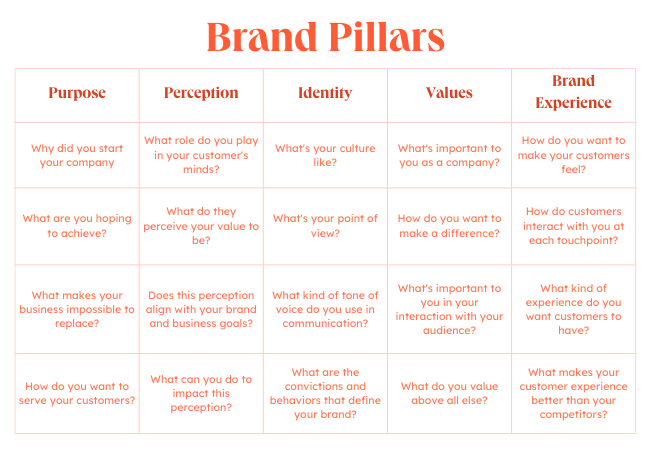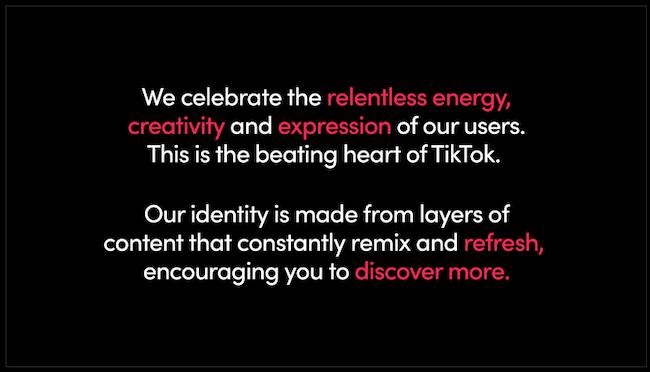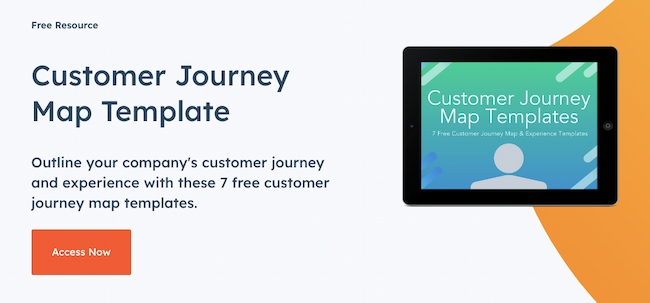The Beginner’s Guide to Brand Pillars
Marketing and branding have been around for centuries. But brand pillars are a newer idea.
Since the dawn of the digital age, companies have marketed their brands with the goal of giving their company a personality and identity.
But as the practice of branding has evolved, so have audience expectations. Businesses today need more than a catchy tagline to support customer needs. Companies aren’t just selling products anymore — they create brands that need to talk about their impact on society.
In this post, we’ll discuss how to create brand pillars that can help you define your brand’s purpose, values, and identity for continued growth. Keep reading or jump ahead to learn:
- What are brand pillars?
- Why are brand pillars important?
- What are the five brand pillars?
- How to Determine Your Brand Pillars
- Brand Pillar Examples
For example, brand pillars can be core values, important strengths, or aspects of a brand that support or add dimension to the core idea of “Who are you?”
Essentially, these brand pillars can be anything that your customers find important — perhaps it’s innovation, reliability, or on-time delivery.
Brand pillars can differentiate your brand and should be valued and endorsed by your customers. When someone asks why your customers like your brand, you’ll want them to be able to list your brand pillars too.
These pillars should be strategic decisions to offer better products or services to your customers.
Why are brand pillars important?
Brands are essential, especially in competitive industries, to grow awareness and value for a company. A strong brand is a point of connection for customers. It helps a business quickly communicate the essence of its vision and value.
But branding is also a subjective process. It trades in the currency of opinion, making it subject to trends, fickle followers, and more. So, the stronger a brand’s foundation is, the more likely it is to weather the storms of change.
Brand pillars are an integral part of this foundation. They are touchpoints that help a brand define and codify its distinct value. Each brand pillar is a step toward clearer communication.
Each pillar breaks down the many nuances of a new brand. This helps the public connect the brand to the products and services a business offers. It also helps customers, stakeholders, and investors understand what it means to support your company.
I know this might sound slightly conceptual. But brand pillars can be easier to understand when we break them down into categories. Below, let’s learn about the five brand pillar categories you can use to determine your own brand pillars.
The main brand pillars are purpose, perception, identity, values, and brand experience.

1. Purpose
Purpose can be described as the mission and foundation of your company. It will answer questions like “Why did you start your company?” and “What are you hoping to achieve?”
Think about this strategically. What do you want to communicate to your audience as your purpose? What do you want to communicate to employees or potential employees? Knowing your purpose will help you hire employees who align with your mission and correctly target your audience.
Purpose can even be described as the culture of your company. For example, at HubSpot, our culture is about growth-minded individuals who have HEART (they are humble, empathetic, adaptable, remarkable, and transparent). The acronym HEART is one of our brand pillars as a company.
2. Perception
Perception is about how your customers perceive your company and brand. You’ll want to check how current customers view your brand. Or if you’re a new company, write down some characteristics that you’d like customers to associate with your brand.
This could be something like hospitality or leadership. If these are your perception brand pillars, then you want customers to view you as a leader in your industry that is a trusted, good host (this makes sense for a hotel, for example).
3. Identity
This brand pillar is about who you are as a brand. A brand is something you are, it’s not something you have. It’s all about your personality as a company.
For example, an identity brand pillar could be something like “cheeky” or “bold.” This means that you want customers to see you as having a cheeky personality. The reason to define this brand pillar is so you have a guiding light for how to be human and interact with your customers.
4. Values
Your values are about communicating your overall position to your audience. What’s important to you as a company? How do you want to make a difference? This could be something like valuing integrity and ownership.
5. Brand Experience
Lastly, brand experience is a pillar that will help you promote your products and services. People use products and services when they like a brand. There are so many options to choose from these days, customers tend to buy from companies they like. This means you need to create a positive customer experience and association with your overall brand.
By using these brand pillars as a basis, you can create a brand identity that sets you apart from your competition. Companies that fail most likely haven’t considered what their brand pillars are and how they align.
If you have a robust strategy, but you don’t have a purpose or identity, people won’t feel compelled to purchase from you. But if you promise that you value user experience, but the perception is off, then you also won’t find success.
In the next section, let’s review how you can use these categories to define your brand pillars.
To determine your brand pillars, think about your brand strategy and come up with things that clearly define your personality, voice, customer experience, purpose, and how people will perceive your brand.
1. Refine Your Company’s Purpose
More than 60% of entrepreneurs start a business because they want to be their own boss. But dig a little deeper, and there are many reasons that people start businesses.
Sometimes it’s finding something that’s missing in an industry they’re familiar with. Or the product could relate to a goal they want to achieve, like improving remote technology access.
As your business gets off the ground, you may need to focus on funding, overhead, and hiring. This can impact your ability to remember this initial driving purpose for your business.
But this purpose is often the core of your brand. When creating brand pillars, it’s easy to write something that sounds good but doesn’t really mean anything. For example, a brand pillar of service sounds great. But if there isn’t a purpose that shores up that broad concept, service is just something that every business does.
As you nail down the purpose of your company, think about what your audience would do if your company didn’t exist. What makes your business impossible to replace? Is it your people? Your approach to manufacturing? Your quality assurance?
There is a purpose behind every decision you make as a company. Before you draft your brand pillars, revisit and refine that purpose. And if you’re looking for some inspiration, check out mission statement examples from other brands you admire.
Featured Resources: Mission Statement Examples
Then, ask yourself:
- Why did you/are you starting your company?
- What do you want to make happen?
- How do you want to serve your customers?
- What value do you offer to customers to support your mission and vision?
Your purpose pillar should serve as a magnet for employees and customers who share similar values. It will also offer a hook to tell your company’s story and differentiate yourself from your competition.
2. Research to Understand How Customers See Your Brand
Whether you’re making new brand pillars or creating pillars as part of your rebranding efforts, customer perception is key.
Start with what your audience already knows about your brand to meet their high expectations. Use social listening and reputation management tools to get a sense of how customers feel about your brand.
Then, track your customer journey. At each step, gather customer feedback on experiences with your brand and products. As you collect these insights, ask yourself:
- What role do you play in your customer’s minds?
- What do they perceive your value to be?
For example, say people view you as a place they go to learn about your industry. Does this perception align with your brand and business goals? What can you do to impact this perception?
Featured Resource: Customer Journey Template
You may also want to use customer profile templates or create an ideal customer profile. These tools can help you narrow down the target audience for your research.
While it can be tempting to make guesses about how your customers feel and how they want to engage with your brand, it’s best to pair your hunches with data.
This deeper understanding of your customers can help you create a perception brand pillar that resonates with them.
3. Develop Your Brand Identity
Brand identity is more than your business name, slogan, and logo. It’s more than your brand voice or other brand elements.
When it comes to brand pillars, your brand identity is a composite personality. It’s a mashup of the community you’ve built in your company and how those voices come together. Your brand identity will show how incredible the different groups that make your company are when they come together.
But to create a strong pillar, that identity needs to be authentic. You can’t just invent what you want your identity to look and sound like. It should come from the consistent voice of your team, products, and brand. And it should naturally come into everything that you do as a business.
To develop your identity pillar, ask these questions:
- What’s your culture like?
- What’s your point of view?
- What kind of tone of voice do you use in communication?
- What are the convictions and behaviors that define your brand?
Defining your voice and brand is about strategizing how you want to speak to your audience on several platforms. The brand personality signals what employees might be like, how they behave, and who your customers are.
4. Define Your Company Values
Company values help you take your business purpose from a vision to an active set of principles. So, if your purpose is the end goal, your values are the path you want to take to achieve that goal as a team.
Your company values usually describe how your business wants to manage relationships and grow. They may directly connect to your brand pillars, or they may inspire your pillars.
As you define your company values pillar, ask:
- What’s important to you in your interaction with your audience?
- What do you value above all else, even before your own financial interests?
This pillar will help define what you care about as a company and why. Use this glossary if you’re not sure how to condense your values into a simple word or phrase.
Featured Resource: Company Values Glossary
5. Create a Powerful Brand Experience
It doesn’t matter how great your brand looks and sounds if it doesn’t create a great experience. Customers make thousands of decisions every day. To create a brand with impact, you need to think about how you can influence those decisions.
It may sound small or insignificant, but choices like how long it takes to put on a pair of shoes or the texture of a noodle can make a difference in how your customers feel. If that brief feeling lasts, they’ll remember it the next time they’re talking on the phone with a friend or scrolling social media.
So, think about creating a great brand experience and setting the right brand pillar for engagement:
- How do you want to make your customers feel?
- How do customers interact with you at each touchpoint?
- What kind of experience do you want customers to have?
- What makes your customer experience better than your competitors?
Brand experience will define much of your perceived personality and reputation. When creating your brand pillars, think about what your customers get from you. Do they get convenience, higher quality, or time savings?
6. Test Your Ideas
A draft can sound great but not work out when it’s applied to a real-life situation. And a big idea can make business sense, but not resonate with customers. So, once you’ve drafted your brand pillars, verify your ideas.
You may want to run surveys with your internal team or a select group of customers. Focus groups and A/B testing are also useful strategies.
You may also want to run some competitive analysis to see whether your brand pillars measure up against others in your industry.
After early testing and launch, do regular testing to see if your brand perception needs an update to evolve with your customer needs.
7. Adjust Your Brand Strategy to Meet Customer Needs
After you collect customer data about your brand pillars, put it to good use. It can be tempting to create a brand pillar strategy and hold on to it for the life of your brand. But sometimes your company must change with your customers.
Besides changing your strategy, find ways to proactively communicate changes to your audience. A product launch can often feel like a big event inside an organization, but fall flat because the message didn’t reach the right audience.
Use your analytics to measure the channels and platforms where your brand pillars come into play. Then, use those insights to balance customer expectations with business goals.
That said, sometimes a mini-pivot or extra segmentation is enough to align your brand pillars with customer needs. Don’t try to change the foundation of your brand with every new trend.
Brand Pillar Examples
1. Hilton

Hilton’s brand pillars are clearly stated on its website. They value Hospitality, Integrity, Leadership, Teamwork, Ownership, and Now (a sense of urgency).
These are their stated values, but they’re really brand pillars. They showcase how the company wants to be perceived, what its identity is, what the customer experience is like, and what they value.
2. TikTok

TikTok’s core brand page highlights its brand pillars with a voice that’s as clear and quick as the platform experience. Their purpose is to help users discover more and to create the perception of a constant refresh for their users.
TikTok’s identity is the expression of its users. It changes as its user base changes and its value lies in the creativity of its customers. These pillars support a brand experience of relentless energy that explains the meteoric growth of this social platform.
3. Savage X Fenty

This “About” page highlights brand pillars for Savage X Fenty that are the foundation of this potent brand. With brand pillars of fearlessness, confidence, inclusion, accessibility, and individuality, it quickly communicates the core of its brand purpose, identity, and experience to a wide audience.
4. Patagonia

Patagonia is a brand that has personality and purpose. Their mission is to use business to protect nature (this is their purpose). Plus Patagonia aims to build the best product, cause no unneeded harm, and create new ways of doing things (this is their personality and values).
With this brand, values and purpose are the center of the brand, so they form its pillars.
5. Samsung

The larger a brand gets, the more difficult it can be to stick with defined brand pillars.
Samsung is a global corporation with a diverse technology product portfolio. This means its brand pillars don’t just need to speak to B2C customers purchasing mobile phones and digital displays. It also needs to communicate its purpose, values, and identity to B2B customers in networks, health, and medical equipment.
Pillars like progressive innovation and defiant optimism show a commitment to the brand’s continued growth in technology. At the same time, pillars like integrity, transparency, and social betterment put an emphasis on its values.
6. Silver and Riley

This luxury fashion brand uses brand pillars to ground its brand voice. Silver and Riley‘s purpose, to provide luxury bags at an attainable price, is front and center. The brand puts emphasis on principles like diversity, inclusivity, and customer focus to show the different brand pillars that support the overall goal.
7. Nike

Since its founding, Nike has been consistent in its brand pillars. They are all about competition and surpassing one’s limits. All the company’s advertising, messaging, and investment decisions support that personality and value.
Use Brand Pillars to Grow Your Influence
Brand pillars are a useful way to shore up your brand strategy. They can help define and differentiate your company from the competition. And you can use brand pillars to build awareness and shape sentiment about your brand.
Because it’s not just about making products anymore — it’s about having a voice and point of view that offers value to its customers.
Editor’s note: This post was originally published in June 2021 and has been updated for comprehensiveness.
![]()






